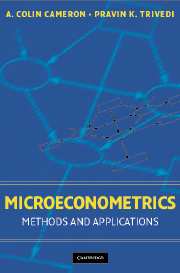 A. Colin Cameron and Pravin
K. Trivedi
A. Colin Cameron and Pravin
K. Trivedi
MICROECONOMETRICS: Methods and Applications
Cambridge University Press, New York
May 2005
PART 3 (chapters 11-13)
Part 1 emphasized that: (1) Microeconometric models are often nonlinear;
(2) they are frequently estimated using large and heterogeneous data sets;
and (3) the data often come from surveys that are complex and subject
to a variety of sampling biases. A realistic depiction of the economic
phenomena in such settings often requires the use of models that are difficult
to estimate and analyze. Advances in computing hardware and software
now make it feasible to tackle such tasks. Part 3 presents modern, computer-intensive,
simulation-based methods of inference that mitigate some of these difficulties.
The background required to cover this material varies somewhat with the chapter
but the essential base is least squares and maximum likelihood estimation.
Chapter 11 presents bootstrap methods for statistical inference. These methods
have the attraction of providing a simple way to obtain standard errors when
the formulae from asymptotic theory are complex, as is the case for some
two-step estimators. Furthermore, if implemented appropriately, a bootstrap
can lead to a more refined asymptotic theory that may then lead to better
statistical inference in small samples.
Chapter 12 presents simulation-based estimation methods. These methods permit
estimation in situations where standard computational methods may not permit
calculation of an estimator, because of the presence of an integral over
a probability distribution for which there is no closed-form solution.
Chapter 13 surveys Bayesian methods that provide an approach to estimation
and inference that is quite different from the classical approach used in
other chapters of this book. Despite this different approach, the Bayesian
toolkit can also be adopted to permit classical estimation and inference
for problems that are otherwise intractable.
Back to Main Page
 A. Colin Cameron and Pravin
K. Trivedi
A. Colin Cameron and Pravin
K. Trivedi